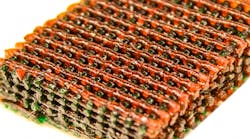A team of professors from MIT, Columbia, and Duke developed a tough new hydrogel that will take 3D printing of intricate, load-bearing body parts to the next level.
An interpenetrating network of crosslinked polyethylene glycol (PEG) and sodium alginate yields a hydrogel with a high fracture energy that can be stretched to five times its original length without breaking. Structures can also be compressed by 99% and return to their original shape. The hybrid hydrogel is especially different from competing hydrogels because toxic chemicals are not needed for its synthesis, so it can be seeded safely with living cells during printing.
Ionic crosslinking of sodium alginate with Ca2+ ions dissipates mechanical loads, as proven in previous hydrogel experiments. Dissipating energy, or converting mechanical energy into heat, is important so that mechanical energy will not break crosslinks and propagate cracks through the material. Crosslinking with PEG chains is critical because they increase the hydrogel’s stretchability, as the long covalent crosslinks allow the material to be pulled.
Alone, these materials are limited. PEG hydrogels have low fracture energy and, therefore, can’t be stretched too far. Sodium alginate bolsters the PEG with Ca2+ crosslinks to dissipate loads, increasing the material’s fracture energy. Meanwhile, sodium-alginate hydrogels with Ca2+ crosslinks alone can’t be stretched and don’t exhibit resiliency.
The team tested several molecular weights of the PEG, each with and without crosslinked alginate. Through experiments, the scientists were able to determine the prime PEG molecular weight (length) and Ca2+ concentration for the toughest, most resilient result. They also added a “nanoclay” in different quantities between network spaces, in order to vary the material’s viscosity for feeding through a 3D printer.
The hydrogel is expected to find homes in many biomedical applications, as well as robotics. The scientists hope to improve the resolution of the 3D printers to enhance the qualities of the interdependent matrix and produce highly accurate structures.

